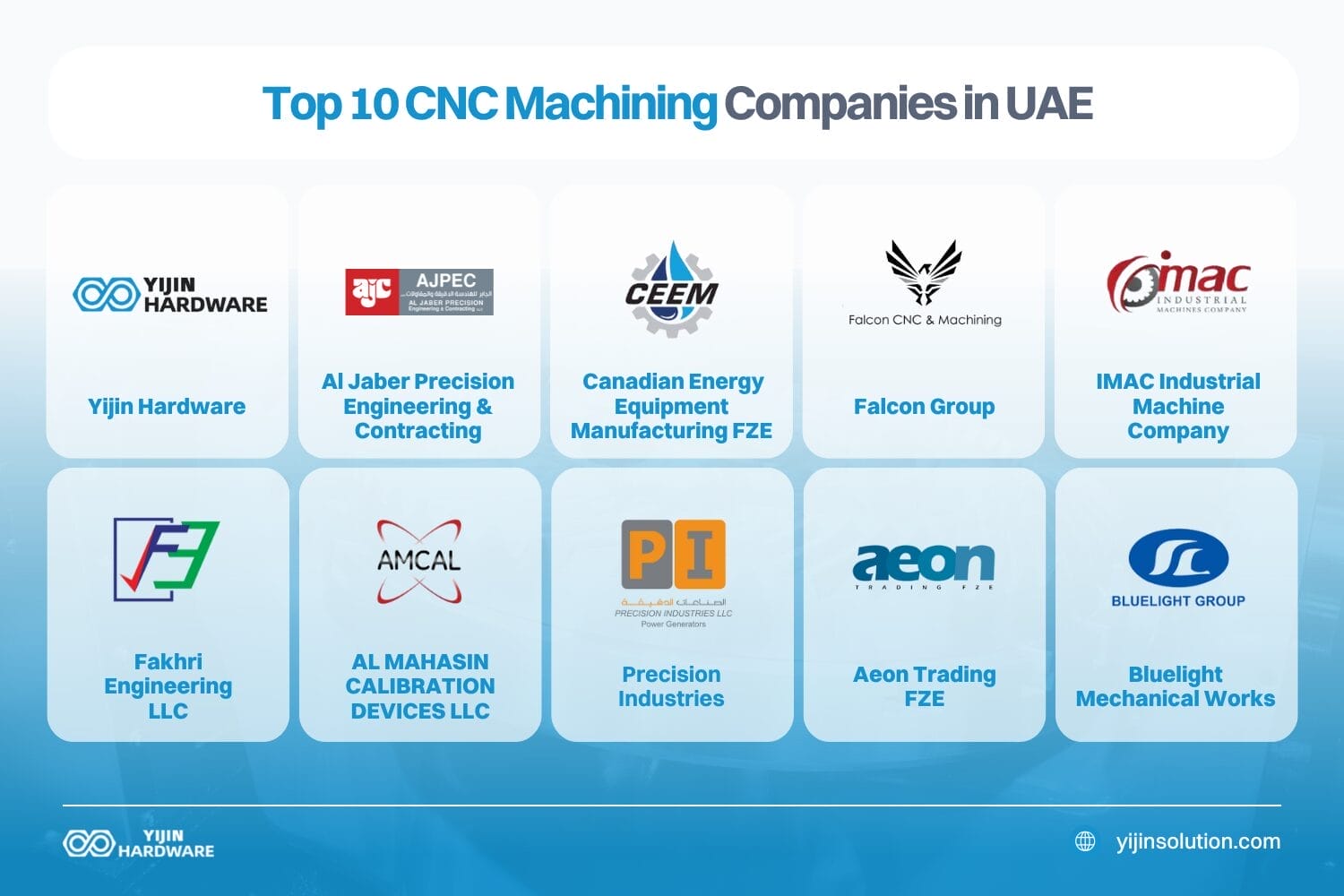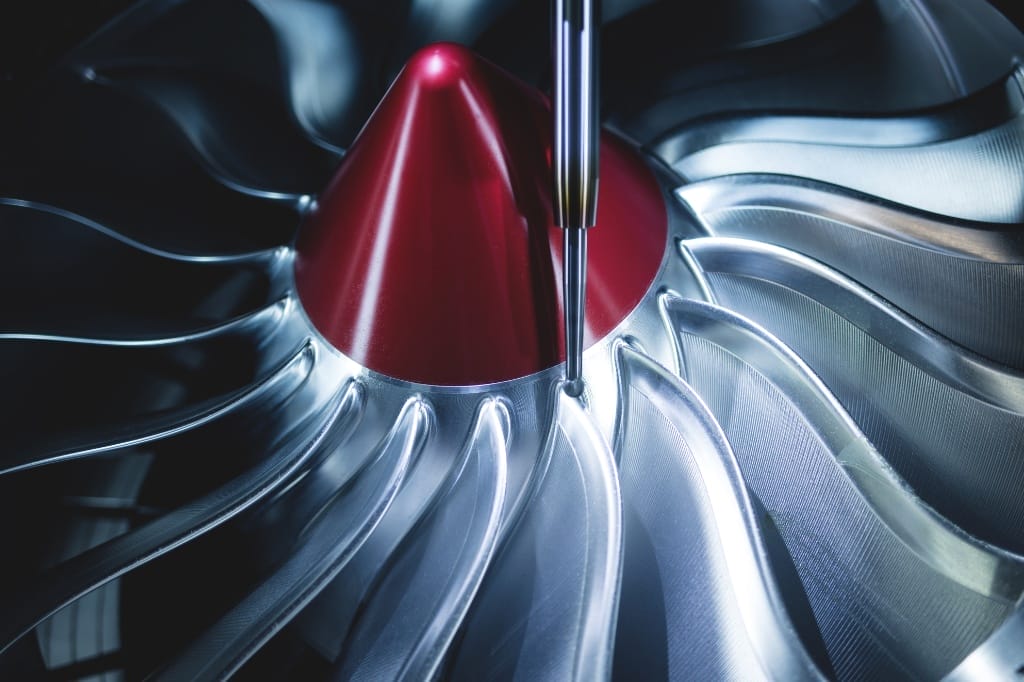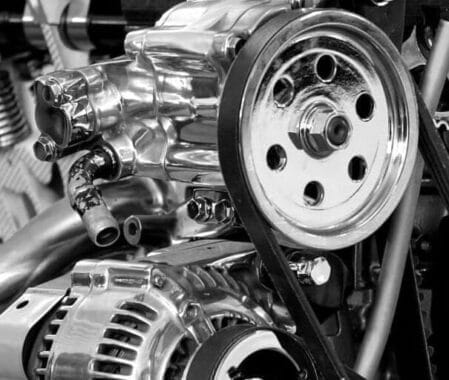Parts with angled features, details on multiple sides, or radial patterns are a pain to make with traditional 3-axis machining. You’re stuck doing multiple manual setups, which eats uptime, introduces positioning errors, and stacks up tolerances until your dimensional accuracy goes out the window.
At Yijin Hardware, our 4-axis Обработка на станках с ЧПУ fixes all that by adding rotational capability (the A-axis) to the standard X, Y, and Z movements, so we can machine all sides of your part in one setup, hitting tolerances as tight as ±0.015 mm on aluminum alloys.
Основные выводы
- 4-axis CNC adds A-axis rotation around the X-axis to three linear axes (X/Y/Z), enabling 360° workpiece access without repositioning
- Achieves ±0.015 mm tolerance on aluminum, ±0.020 mm on steel, with Ra 0.4 μm surface finish standard
- Eliminates multiple setups required for 3-axis multi-sided machining, reducing positioning errors and tolerance stack-up
- ISO 9001 and IATF 16949 certified facility serves aerospace, automotive, medical device, and industrial applications
- Continuous and indexing capabilities handle everything from simple rotational features to highly complex 3D shapes
Что такое 4-осевая обработка с ЧПУ?
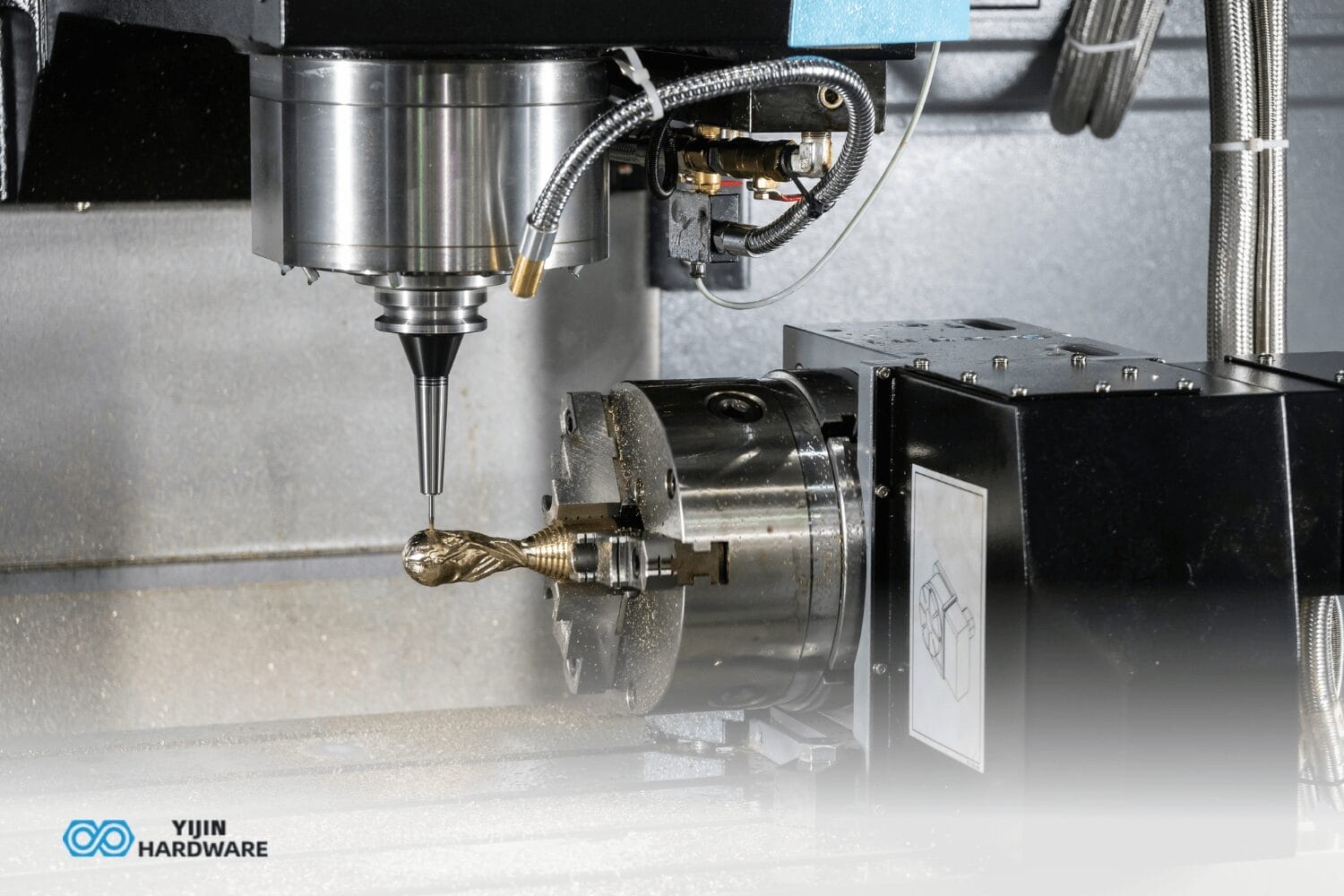
A 4-axis CNC machine operates on four axes: three linear axes (X, Y, Z) plus one rotary axis (A-axis) that rotates around the X-axis. This type of machining enables 360° workpiece rotation, allowing cutting tools to access multiple part faces without manual repositioning. The additional axis allows for the creation of complex parts impossible with 3-axis machines (linear movement only) and differs from 5-axis machines (which add B-axis and C-axis rotation).
Согласно PMC, optimized feed rates in 4-axis machining lower the force on tools by nearly 30%, which helps tools last longer and improves quality, though it might make the cutting take a little more time.
Core Components and CNC Technology
The system includes a CNC spindle holding the cutting tool, a rotary table or tombstone fixture supporting components, and a control unit running CAM software. We use CAM programs like Mastercam, Fusion 360, and SolidWorks CAM to generate G-code instructions. These programs coordinate simultaneous movement across all four different axes with precision measured in thousandths of millimeters, giving operators complete control over the machining process.
| Тип машины | Primary Use | Key Advantage |
|---|---|---|
| Четырехкоординатный фрезерный станок | Angled cuts, slots, complex features | Most versatile for complex geometries |
| 4-Axis CNC Lathe | Turning operations with radial features | Excellent for cylindrical parts with cross-holes |
| 4-Axis CNC Router | Large parts, woodworking | Handles oversized workpieces efficiently |
How does 4-Axis CNC Machining Work?
4-axis CNC machining works through coordinated movement where the rotary axis rotates the workpiece while the spindle moves along X, Y, and Z axes while simultaneously rotating to cut material. The system positions parts at precise angles, either stopping at fixed positions (indexing mode) or rotating continuously during cutting. G-code programs control these synchronized movements, with the tool path optimized for efficient material removal.
The Manufacturing Process
CAD to CAM Programming Engineers create дизайны and 3D models that convert to formats like STEP or IGES. CAM software generates toolpaths calculating rotation axis angles coordinated with linear movement, optimizing cutting speeds and feed rates.
Machine Setup and Execution: We mount components on rotary tables or tombstone fixtures capable of holding parts up to 762×500×508 mm. The cutting tool approaches the workpiece from multiple angles as rotation occurs. Continuous machines rotate during cutting for cam profiles and helical features, while indexing machines lock at specific angles between cuts.
Проверка качества CMM (Coordinate Measuring Machine) inspection verifies critical dimensions. We implement Statistical Process Control (SPC) for production runs, documenting measurements that confirm tolerance achievement per ISO 9001:2015 standards.
What Makes 4-Axis Machining Better than 3-Axis?
The difference between 3-axis and 4-axis lies in the additional rotary axis that consolidates multiple operations into a single setup. This axis machine configuration eliminates repositioning time and prevents tolerance stack-up errors. Parts with features on 4 sides complete faster because all operations occur from a single datum reference, with setup reduction saving 15–30 minutes per eliminated setup.
Precision and Capability Advantages
- Алюминий Alloys (6061-T6, 7075-T6): ±0.015 mm tolerance
- Нержавеющая сталь (304, 316, 17-4PH): ±0.020 mm tolerance
- Титан (Ti-6Al-4V): ±0.018 mm tolerance
- Отделка поверхности: Ra 0.4 μm standard
The extra axis allows machining of geometries impossible with three axes:
- Angled holes at any orientation beyond perpendicular planes
- Helical features like spiral flutes requiring continuous rotation
- Cam lobes with continuously changing profiles
- Multi-sided parts with precise angular relationships
- Undercuts accessible only from specific tool approach angles
What Parts Require 4-Axis CNC Machining?
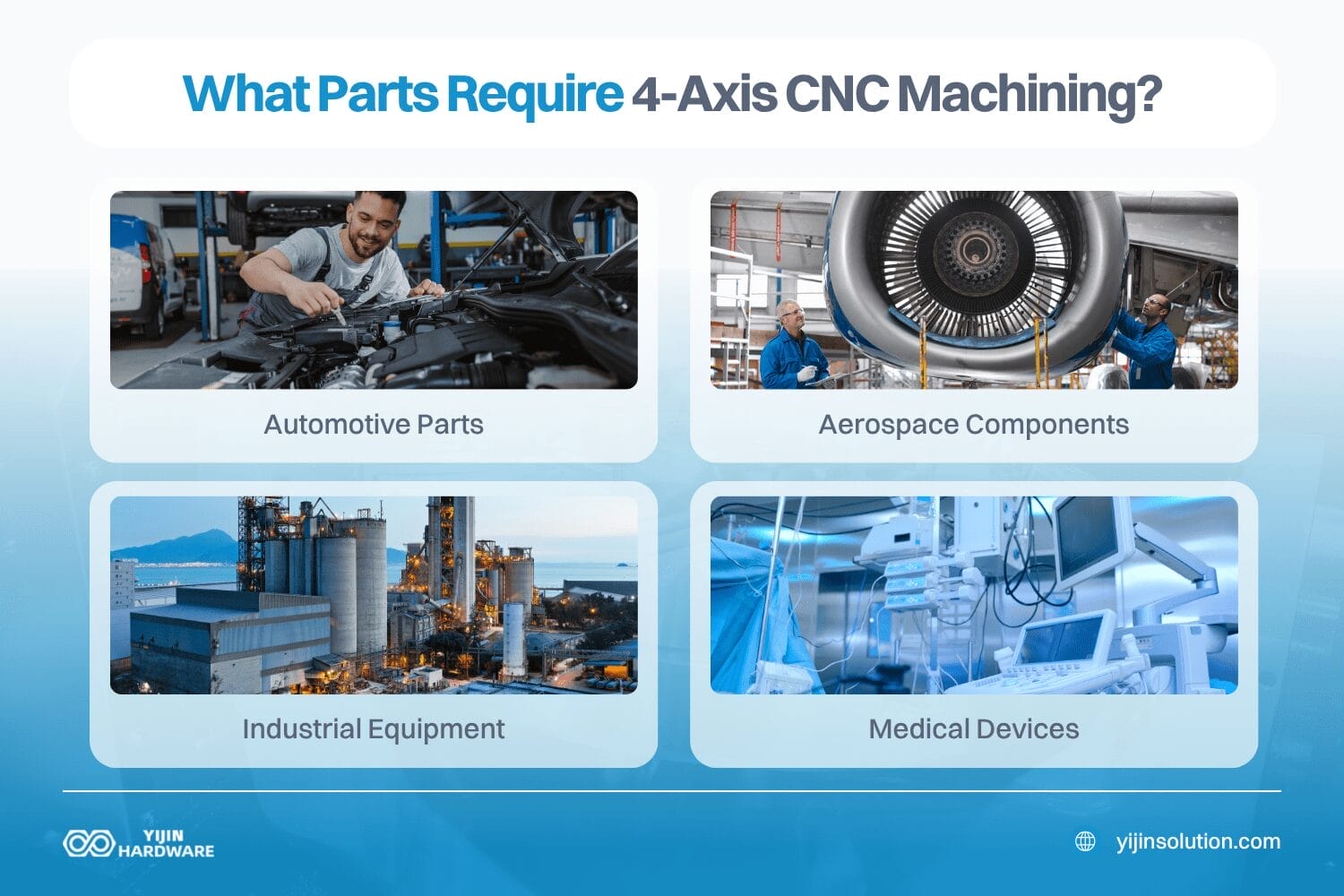
Multi-axis machining becomes essential for components with angled features not perpendicular to primary planes, cylindrical parts with radial features, and housings with features on three or more faces. This advanced machining capability opens up new possibilities for producing turbine blades, cam shafts, surgical instruments, and complex brackets that would require expensive fixtures on simpler axis CNC machines.
- Аэрокосмическая промышленность Components: Turbine blades, impellers, structural brackets using titanium Ti-6Al-4V and 7075-T6 aluminum
- Автомобили Parts: Transmission housings, engine components requiring IATF 16949 certification
- Медицина Devices: Surgical instruments, orthopedic implants from biocompatible 316L stainless steel with ISO 13485 traceability
- Промышленное оборудование: Valve bodies, pump components from corrosion-resistant alloys
What Materials Work with 4-Axis CNC Machining?
This type of machining accommodates metals including aluminum alloys (6061-T6, 7075-T6, 2024, 5052), stainless steels (304, 316, 17-4PH), titanium grades (Ti-6Al-4V, commercially pure), латунь C360, медь C110, and tool стали (4140, 4340, A2, D2). Engineering plastics like Delrin, PEEK, нейлон, PTFE, and поликарбонат also machine successfully.
| Категория материала | Specific Grades | Толерантность | Приложения |
|---|---|---|---|
| Алюминиевые сплавы | 6061-T6, 7075-T6, 2024 | ±0.015 mm | Aerospace, electronics |
| Нержавеющая сталь | 304, 316, 316L, 17-4PH | ±0.020 mm | Medical, marine |
| Титан | Ti-6Al-4V, CP Titanium | ±0.018 mm | Аэрокосмическая промышленность, имплантаты |
| Инженерные пластики | Delrin, PEEK, Nylon | ±0.030 mm | Insulators, bushings |
We provide material certifications including mill test reports (MTRs), certificates of conformance, and DFARS-compliant sourcing meeting ASTM standards.
How do We Ensure Quality in 4-Axis Machining?
We ensure quality through ISO 9001:2015 certified quality management systems and IATF 16949 automotive certification. Every part receives CMM inspection verifying critical dimensions to ±0.015 mm. Statistical Process Control (SPC) monitors production runs, tracking measurements that identify dimensional drift before parts fall outside tolerance limits.
Our machinists hold NIMS (National Institute for Metalworking Skills) certifications validating hands-on competency in CNC setup, programming, and operation. These industry-recognized credentials ensure consistent quality across all shifts, meeting requirements from AS9100 aerospace standards to ISO 13485 medical device specifications.
What’s the Difference Between Indexing and Continuous 4-Axis?
Indexing 4-axis machining rotates to fixed angular positions (0°, 90°, 180°, 270°), locks position, then machines features before rotating to the next index. Continuous 4-axis machining, where the two axes (one linear, one rotational) or more operate independently, rotates smoothly during cutting operations, with the axis of rotation coordinating with X/Y/Z movement to create helical features and sculptured contours.
Indexing Applications: Multi-sided brackets, cylindrical parts with radial hole patterns, rectangular housings with pockets on each side
Continuous Applications: Cam lobes, helical gear teeth, impeller blades with twisted contours, any feature where the rotation in the B-axis or A-axis must occur during cutting
The world of CNC machining shows that approximately 70% of parts requiring beyond-3-axis capabilities work with indexing mode, which offers simpler CAM programming.
Ready to Start Your 4-Axis CNC Machining Project?
At Yijin Hardware, we combine ISO 9001 and IATF 16949 certified quality systems with advanced 4-axis CNC technology to deliver precision parts meeting aerospace, automotive, and medical device standards. Our experienced engineering team provides free Design for Manufacturing analysis, identifying opportunities to optimize your designs for efficient production with tolerances down to ±0.015 mm.
Whether you need prototype development or full production runs, our 4-axis machining capabilities deliver the geometric complexity and dimensional accuracy your applications demand. Contact our engineering team today to discuss your project requirements and receive a detailed quote.
4-Axis CNC Machining FAQs
What is the difference between 3-axis and 4-axis CNC machines?
A 3-axis machine moves cutting tools along three linear axes (X, Y, Z) only, while a 4-axis machine adds rotational capability that spins workpieces for multi-sided access. This fundamental difference means 3-axis requires manual workpiece repositioning to machine features on multiple faces, consuming 15–30 minutes per setup change. Each repositioning introduces potential tolerance stack-up, whereas 4-axis maintains a single datum throughout production.
What is the difference between 4-axis and 5-axis CNC machines?
Deciding between 4-axis or 5-axis depends on part complexity. A 4th axis machine provides rotation around one axis, while 5-axis machines add two rotational axes, typically the 5th axis providing B-axis (rotating around Y) or C-axis (rotating around Z), enabling the cutting tool to approach the workpiece from virtually any angle. The two main types of 5-axis configurations either tilt the table or tilt the spindle head.
What are the disadvantages of a 4-axis CNC machine?
A 4-axis CNC machine carries higher capital costs compared to a 3-axis machine, translating to increased hourly rates that can make this type of machining uneconomical for simple parts where 3-axis milling suffices. Programming complexity increases because software must coordinate four simultaneous movements, requiring operators with advanced training in multi-axis toolpath strategies and G-code programming with CNC machines like these.
Вернуться к началу: Услуги по 4-осевой обработке с ЧПУ






